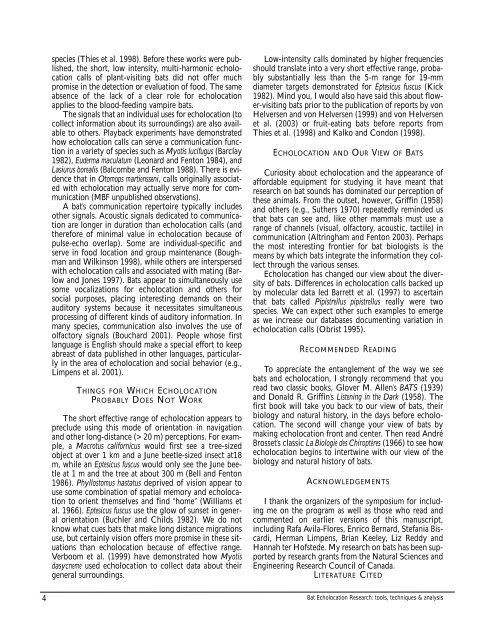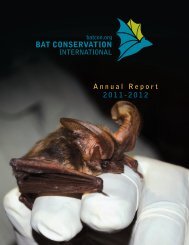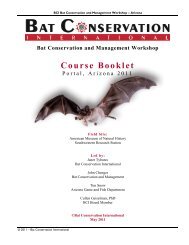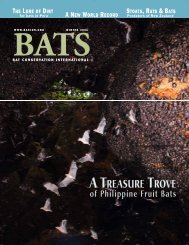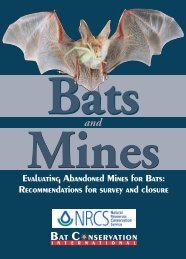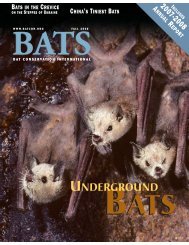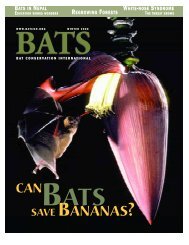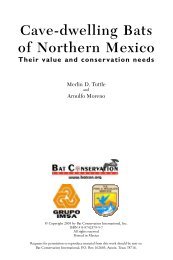Bat Echolocation Researc h - Bat Conservation International
Bat Echolocation Researc h - Bat Conservation International
Bat Echolocation Researc h - Bat Conservation International
You also want an ePaper? Increase the reach of your titles
YUMPU automatically turns print PDFs into web optimized ePapers that Google loves.
species (Thies et al. 1998). Before these works were published,<br />
the short, low intensity, multi-harmonic echolocation<br />
calls of plant-visiting bats did not offer much<br />
promise in the detection or evaluation of food. The same<br />
absence of the lack of a clear role for echolocation<br />
applies to the blood-feeding vampire bats.<br />
The signals that an individual uses for echolocation (to<br />
collect information about its surroundings) are also available<br />
to others. Playback experiments have demonstrated<br />
how echolocation calls can serve a communication function<br />
in a variety of species such as Myotis lucifugus (Barclay<br />
1982), Euderma maculatum (Leonard and Fenton 1984), and<br />
Lasiurus borealis (Balcombe and Fenton 1988). There is evidence<br />
that in Otomops martiensseni, calls originally associated<br />
with echolocation may actually serve more for communication<br />
(MBF unpublished observations).<br />
A bat’s communication repertoire typically includes<br />
other signals. Acoustic signals dedicated to communication<br />
are longer in duration than echolocation calls (and<br />
therefore of minimal value in echolocation because of<br />
pulse-echo overlap). Some are individual-specific and<br />
serve in food location and group maintenance (Boughman<br />
and Wilkinson 1998), while others are interspersed<br />
with echolocation calls and associated with mating (Barlow<br />
and Jones 1997). <strong>Bat</strong>s appear to simultaneously use<br />
some vocalizations for echolocation and others for<br />
social purposes, placing interesting demands on their<br />
auditory systems because it necessitates simultaneous<br />
processing of different kinds of auditory information. In<br />
many species, communication also involves the use of<br />
olfactory signals (Bouchard 2001). People whose first<br />
language is English should make a special effort to keep<br />
abreast of data published in other languages, particularly<br />
in the area of echolocation and social behavior (e.g.,<br />
Limpens et al. 2001).<br />
THINGS FOR WHICH ECHOLOCATION<br />
PROBABLY DOES NOT WORK<br />
The short effective range of echolocation appears to<br />
preclude using this mode of orientation in navigation<br />
and other long-distance (> 20 m) perceptions. For example,<br />
a Macrotus californicus would first see a tree-sized<br />
object at over 1 km and a June beetle-sized insect at18<br />
m, while an Eptesicus fuscus would only see the June beetle<br />
at 1 m and the tree at about 300 m (Bell and Fenton<br />
1986). Phyllostomus hastatus deprived of vision appear to<br />
use some combination of spatial memory and echolocation<br />
to orient themselves and find “home” (Williams et<br />
al. 1966). Eptesicus fuscus use the glow of sunset in general<br />
orientation (Buchler and Childs 1982). We do not<br />
know what cues bats that make long distance migrations<br />
use, but certainly vision offers more promise in these situations<br />
than echolocation because of effective range.<br />
Verboom et al. (1999) have demonstrated how Myotis<br />
dasycneme used echolocation to collect data about their<br />
general surroundings.<br />
Low-intensity calls dominated by higher frequencies<br />
should translate into a very short effective range, probably<br />
substantially less than the 5-m range for 19-mm<br />
diameter targets demonstrated for Eptesicus fuscus (Kick<br />
1982). Mind you, I would also have said this about flower-visiting<br />
bats prior to the publication of reports by von<br />
Helversen and von Helversen (1999) and von Helversen<br />
et al. (2003) or fruit-eating bats before reports from<br />
Thies et al. (1998) and Kalko and Condon (1998).<br />
ECHOLOCATION AND OUR VIEW OF BATS<br />
Curiosity about echolocation and the appearance of<br />
affordable equipment for studying it have meant that<br />
research on bat sounds has dominated our perception of<br />
these animals. From the outset, however, Griffin (1958)<br />
and others (e.g., Suthers 1970) repeatedly reminded us<br />
that bats can see and, like other mammals must use a<br />
range of channels (visual, olfactory, acoustic, tactile) in<br />
communication (Altringham and Fenton 2003). Perhaps<br />
the most interesting frontier for bat biologists is the<br />
means by which bats integrate the information they collect<br />
through the various senses.<br />
<strong>Echolocation</strong> has changed our view about the diversity<br />
of bats. Differences in echolocation calls backed up<br />
by molecular data led Barrett et al. (1997) to ascertain<br />
that bats called Pipistrellus pipistrellus really were two<br />
species. We can expect other such examples to emerge<br />
as we increase our databases documenting variation in<br />
echolocation calls (Obrist 1995).<br />
RECOMMENDED READING<br />
To appreciate the entanglement of the way we see<br />
bats and echolocation, I strongly recommend that you<br />
read two classic books, Glover M. Allen’s BATS (1939)<br />
and Donald R. Griffin’s Listening in the Dark (1958). The<br />
first book will take you back to our view of bats, their<br />
biology and natural history, in the days before echolocation.<br />
The second will change your view of bats by<br />
making echolocation front and center. Then read André<br />
Brosset’s classic La Biologie des Chiroptères (1966) to see how<br />
echolocation begins to intertwine with our view of the<br />
biology and natural history of bats.<br />
ACKNOWLEDGEMENTS<br />
I thank the organizers of the symposium for including<br />
me on the program as well as those who read and<br />
commented on earlier versions of this manuscript,<br />
including Rafa Avila-Flores, Enrico Bernard, Stefania Biscardi,<br />
Herman Limpens, Brian Keeley, Liz Reddy and<br />
Hannah ter Hofstede. My research on bats has been supported<br />
by research grants from the Natural Sciences and<br />
Engineering <strong>Researc</strong>h Council of Canada.<br />
LITERATURE CITED<br />
4<br />
<strong>Bat</strong> <strong>Echolocation</strong> <strong>Researc</strong>h: tools, techniques & analysis


